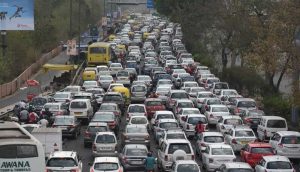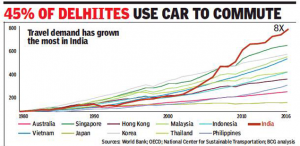In a traffic jam, a vehicle consumes almost 20% more fuel, making travelling a costlier affair

congestion during peak hours in four major cities Delhi, Mumbai, Bengaluru and Kolkata — costs the economy Rs 1.47 lakh crore annually, according to a study conducted by the global consultancy firm.
Delhiites are not only breathing poison they are also burning their car fuel severely due to long traffic jams.
The amount of fuel burnt in just idling of vehicles at traffic intersections amounts to 39,806 kg (diesel, petrol and CNG vehicles combined) and the quantity of carbon dioxide produced equals 1,15,609 kg, that is 115 tonnes of the unhealthy black soot.
As the vehicular population rapidly grows in the capital, the study projects the congestion cost would increase to the tune of around Rs 98,000 crore by 2030 unless steps are taken to tackle the daily mayhem.
Traffic congestion on Delhi roads costs around Rs 60,000 crore annually.
According to findings by one of nation’s top research agencies, Central Road Research Institute (CRRI), Delhi’s eight most erratic traffic bottlenecks are guzzling at least 40,000 kilolitres of fuel daily while vehicles wait in peak rush hours. Worse, it is adding to the city’s pollution with nearly 115 tonnes of carbon dioxide (CO2) being released daily.

Earlier this year, three of the Indian cities (Mumbai, Pune and Kolkata) featured in the list of Top 10 cities with the worst traffic conditions in the world (as per a list put together by Numbeo),” said Garry Singh, managing director of risk consulting and intelligence advisory firm IIRIS Pvt. Ltd.
Dr Neeraj Sharma, principal scientist and head of Environmental Planning Division at CRRI, said, “These are very worrying findings for the city. It indicates towards not just a huge monetary loss but also a loss of health for residents. Production of so much of Co2 (besides other pollutants not recorded in this study) leads to what we call ‘pollution hotspots’ which will definitely lead to a higher incidence of asthma and other respiratory problems. Undoubtedly, the problem is aggravated in winter. The unwell and aged are the most affected.”
“The government needs to go for better road planning and traffic management to reduce idling time of vehicles at traffic points. More plantation of trees is also advised,” he added.


Comments are closed.